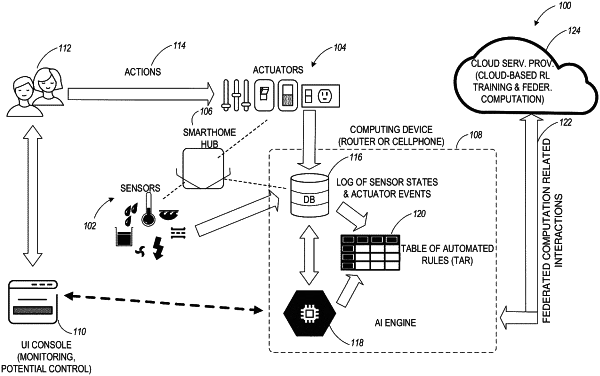| CPC H04L 12/2803 (2013.01) [G06N 20/00 (2019.01); G16Y 10/80 (2020.01); G16Y 20/10 (2020.01); G16Y 20/20 (2020.01); G16Y 40/35 (2020.01)] | 20 Claims |

|
1. A computer-implemented method for automated operation of network devices within a home communication network, the method comprising:
decoding, by at least one processor of a computing device, first information received from a plurality of actuators within the home communication network using a wireless connectivity circuitry of the computing device, the first information indicating a plurality of actuator actions performed by the plurality of actuators within the home communication network based on user interaction, each actuator of the plurality of actuators configured to change a state of at least one network device;
decoding, by the at least one processor of the computing device, second information received from a plurality of sensors in the home communication network using the wireless connectivity circuitry, the second information indicating one or more sensor values generated by the plurality of sensors;
retrieving, by the at least one processor, a machine learning (ML) model from storage of the computing device, the ML model being trained with a training data set of the home communication network to correlate the first information and the second information;
generating, by the at least one processor, a correlation between the plurality of actuator actions and the one or more sensor values based on applying the ML model to the first information and the second information;
generating, by the at least one processor, configuration data based on the correlation, the configuration data comprising:
a trigger graph with one or more trigger conditions, the one or more trigger conditions specifying at least one of the plurality of actuator actions; and
an action graph corresponding to the trigger graph, the action graph indicating one or more automatic actuator actions associated with at least one actuator of the plurality of actuators;
detecting, by the at least one processor, a trigger condition of the one or more trigger conditions specified by the trigger graph; and
causing, by the at least one processor, the at least one actuator of the plurality of actuators to perform the one or more automatic actuator actions indicated by the action graph based on the detecting the one or more automatic actuator actions performed without the user interaction.
|